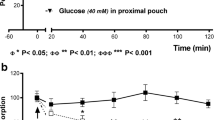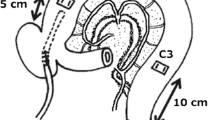Summary
-
1.
Slow peristalsis (less than one peristaltic wave/min) was induced by continuous elevation of intraluminal pressure in vascularly perfused segments of the guinea-pig isolated ileum. The intraluminal pressure at the aboral side of the segment and the volume of fluid propelled by each peristaltic wave were recorded.
-
2.
Intraarterial infusion of substance P (11.5–115 pmoles min−1), cholecystokinin octapeptide (CCK-8; 1.5–15 pmoles min−1), bombesin (1–10 pmoles min−1), and neurotensin (3.6–36 pmoles min−1) dose-dependently stimulated peristalsis, the degree of stimulation being largest with CCK-8. Histamine, a drug contracting the smooth muscle directly, did not stimulate peristalsis.
-
3.
Atropine (1 μM in the bath and perfusion solution) caused a transient inhibition or blockade of the peristaltic reflex, followed by a partial recovery of peristalsis (“atropine-resistant peristalsis”). Atropine-resistant peristalsis was greatly stimulated by CCK-8 (6–15 pmoles min−1), only slightly stimulated by bombesin (4 pmoles min−1), and first stimulated and then inhibited by neurotensin (36 pmoles min−1).
-
4.
Substance P (11.5–1,000 pmoles min−1) inhibited or abolished atropine-resistant peristalsis, which was probably due to desensitization of intestinal smooth muscle and/or neurones against the peptide. [d-Pro2, d-Trp7,9] substance P, an analogue of substance P with antagonistic properties (40 nmoles min−1), also inhibited atropine-resistant peristalsis.
-
5.
Naloxone (4.6 nmoles min−1) stimulated peristalsis both in the absence and in the presence of atropine; this indicates that endogenous opioids modulate peristaltic motility.
-
6.
It is concluded that neuropeptides stimulate peristalsis by exciting intramural cholinergic and non-cholinergic neurones. The inhibitory actions of substance P desensitization and of the substance P antagonist in the presence of atropine indicate that substance P neurones play a role in the mechanism af the atropine-resistant peristalsis.
Similar content being viewed by others
References
Barthó L, Holzer P, Donnerer J, Lembeck F (1982a) Evidence for the involvement of substance P in the atropine-resistant peristalsis of the guinea-pig ileum. Neurosci Lett 32:69–74
Barthó L, Holzer P, Lembeck F, Szolcsányi J (1982b) Evidence that the contractile response of the guinea-pig ileum to capsaicin is due to release of substance P. J. Physiol (Lond) (in press)
Barthó L, Sebök B, Szolcsányi J (1982c) Indirect evidence for the inhibition of enteric substance P neurones by opiate agonists but not by capsaicin. Eur J Pharmacol 77:273–279
Bolton TB (1971) On the nature of the oscillations of the membrane potential (slow waves) produced by acetylcholine or carbachol in intestinal smooth muscle. J Physiol (Lond) 216:403–418
Bortoff A (1976) Myogenic control of intestinal motility. Physiol Rev 56:418–434
Bury RW, Mashford ML (1977) A pharmacological investigation of synthetic substance P on the isolated guinea-pig ileum. Clin Exp Pharmacol Physiol 4:453–461
Erspamer V, Falconicri Erspamer G, Inselvini M, Negri L (1972) Occurrence of bombesin and alytesin in extracts of the skin of three European discoglossid frogs and pharmacological actions of bombesin on extravascular smooth muscle. Br J Pharmacol 45: 333–348
Franco R, Costa M, Furness JB (1979) Evidence for the release of endogenous substance P from intestinal nerves. Naunyn-Schmiedeberg's Arch Pharmacol 306:195–201
Frigo GM, Lecchini S, Falaschi C, Del Tacca M, Crema A (1971) On the ability of caerulein to increase propulsive activity in the isolated small and large intestine. Naunyn-Schmiedeberg's Arch Pharmacol 268:44–58
Fujisawa K, Ito Y (1982) The effects of substance P on smooth muscle cells and on neuro-effector transmission in the guinea-pig ileum. Br J Pharmacol 76:279–290
Furness JB, Costa M (1982) Identification of gastrointestinal neurotransmitters. In: Bertaccini G (ed) Handbook of experimental pharmacology, vol 59/I. Springer, Berlin Heidelberg New York, pp 383–460
Gintzler AR, Scalisi JA (1982) Effects of opioids on noncholinergic excitatory responses of the guinea-pig isolated ileum: inhibition of release of enteric substance P. Br J Pharmacol 75:199–205
Hedner P, Rorsman G (1968) Structures essential for the effect of cholecystokinin on the guinea-pig small intestine in vitro. Acta Physiol Scand 74:58–68
Hirst GDS (1979) Mechanisms of peristalsis. Br Med Bull 35:263–268
Holzer P, Lembeck F (1979) Effect of neuropeptides on the efficiency of the peristaltic reflex. Naunyn-Schmiedeberg's Arch Pharmacol 307:257–264
Holzer P, Lembeck F (1980) Neurally mediated contraction of ileal longitudinal muscle by substance P. Neurosci Lett 17:101–105
Holzer P, Lembeck F, Donnerer J (1980) Caerulein, substance P, serotonin and cholinomimetics induce rhythmic contractions of the intestinal circular muscle. Naunyn-Schmiedeberg's Arch Pharmacol 312:131–137
Holzer P, Emson PC, Iversen LL, Sharman DF (1981) Regional difference in the response to substance P of the longitudinal muscle and the concentration of substance P in the digestive tract of the guineapig. Neuroscience 6:1433–1441
Hutchinson JB, Dockray GJ (1981) Evidence that the action of cholecystokinin octapeptide on the guinea-pig ileum longitudinal muscle is mediated in part by substance P release from the myenteric plexus. Eur J Pharmacol 69:87–93
Hutchinson JB, Dimaline R, Dockray GJ (1981) Neuropeptides in the gut: Quantification and characterization of cholecystokinin octapeptide-, bombesin- and vasoactive intestinal polypeptide-like immunoreactivities in the myenteric plexus of the guinea-pig small intestine. Peptides 2:23–30
Johnson SM, Katayama Y, Morita K, North RA (1981) Mediators of slow synaptic potentials in the myenteric plexus of the guinea-pig ileum. J Physiol (London) 320:175–186
Katayama Y, North RA (1978) Does substance P mediate slow synaptic excitation within the myenteric plexus? Nature 274:387–388
Katayama Y, North RA, Williams JT (1979) The action of substance P on neurones of the myenteric plexus of the guinea-pig small intestine. Proc R Soc B 206:191–208
Kitabgi P, Freychet P (1979) Neurotensin contracts the guinea-pig longitudinal ileal smooth muscle by inducing acetylcholine release. Eur J Pharmacol 56:403–406
Kosterlitz HW, Lees GM (1964) Pharmacological analysis of intrinsic intestinal reflexes. Pharmacol Rev 16:301–339
Kottegoda SR (1970) Peristalsis of the small intestine. In: Bülbring E, Brading A, Jones A, Tomita T (eds) Smooth muscle. Edward Arnold, London, pp 525–541
Kromer W, Pretzlaff W (1979) In vitro evidence for the participation of intestinal opioids in the control of peristalsis in the guinea-pig small intestine. Naunyn-Schmiedeberg's Arch Pharmacol 309:153–157
Kuriyama H, Osa T, Toida N (1967) Nervous factors influencing the membrane activity of intestinal smooth muscle. J Physiol (London) 191:257–270
Leander S, Håkanson R, Rosell S, Folkers K, Sundler F, Tornqvist K (1981) A specific substance P antagonist blocks smooth muscle contractions induced by non-cholinergic, non-adrenergic nerve stimulation. Nature 294:467–469
Mantovani P, Vizi ES (1974) Further observations on the relaxant effect of caerulein on the guinea-pig ileum. J Pharm Pharmacol 26:461–462
Monier S, Kitabgi P (1980) Substance P-induced autodesensitization inhibits atropine-resistant, neurotensin-stimulated contractions in guinea-pig ileum. Eur J Pharmacol 65:461–462
Morita K, North RA, Katayama Y (1980) Evidence that substance P is a neurotransmitter in the myenteric plexus. Nature 287:151–152
North RA (1982) Electrophysiology of the enteric nervous system. Neuroscience 7:315–325
Prosser CL (1978) Rhythmic potentials in intestinal muscle. Fed Proc 37:2153–2157
Rosell S, Björkroth U, Chang D, Yamaguchi I, Wan Y-P, Rackur G, Fisher G, Folkers K (1977) Effects of substance P and analogs on isolated guinea-pig ileum. In: Euler US von, Pernow B (eds) Substance P. Raven Press, New York, pp 83–88
Schultzberg M, Hökfelt T, Nilsson G, Terenius L, Rehfeld JF, Brown M, Elde R, Goldstein M, Said S (1980) Distribution of peptide- and catecholamine-containing neurons in the gastro-intestinal tract of rat and guinea-pig: Immunohistochemical studies with antisera to substance P, vasoactive intestinal polypeptide, enkephalins, somatostatin, gastrin/cholecystokinin, neurotensin and dopamine β-hydroxylase. Neuroscience 5:689–744
Solcia E, Capella C, Buffa R, Usselini L, Tenti P (1982) Morphological basis of gastrointestinal motility: Ultrastructure and histochemistry of endocrine — paracrine cells in the gut. In: Bertaccini G (ed) Handbook of experimental pharmacology, vol 59/I. Springer, Berlin Heidelberg New York, pp 55–78
Tonini M, Frigo G, Lecchini S, D'Angelo L, Crema A (1981) Hyoscineresistant peristalsis in guinea-pig ileum. Eur J Pharmacol 71:375–381
Trendelenburg P (1917) Physiologische und pharmakologische Versuche über die Dünndarmperistaltik. Arch Exp Pathol Pharmakol 81:55–129
van Nueten JM, Janssen PAJ, Fontaine J (1976) Unexpected reversal effects of naloxone on the guinea-pig ileum. Life Sci 18:803–810
Vizi ES, Bertaccini G, Impicciatore M, Knoll J (1972) Acetylcholine-releasing effect of gastrin and related polypeptides. Eur J Pharmacol 17:175–178
Williams JT, Katayama Y, North RA (1979) The actions of neurotensin on single myenteric neurons. Eur J Pharmacol 59:181–186
Zetler (1980) Antagonism of the gut-contracting effects of bombesin and neurotensin by opioid peptides, morphine, atropine or tetrodotoxin. Pharmacology 21:348–354
Author information
Authors and Affiliations
Rights and permissions
About this article
Cite this article
Barthó, L., Holzer, P., Donnerer, J. et al. Effects of substance P, cholecystokinin octapeptide, bombesin, and neurotensin on the peristaltic reflex of the guinea-pig ileum in the absence and in the presence of atropine. Naunyn-Schmiedeberg's Arch. Pharmacol. 321, 321–328 (1982). https://doi.org/10.1007/BF00498521
Received:
Accepted:
Issue Date:
DOI: https://doi.org/10.1007/BF00498521




